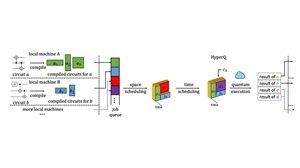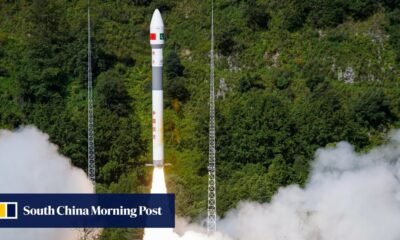AI Research
AI’s next leap demands a computing revolution

We stand at a technological crossroads remarkably similar to the early 2000s, when the internet’s explosive growth outpaced existing infrastructure capabilities. Just as dial-up connections couldn’t support the emerging digital economy, today’s classical computing systems are hitting fundamental limits that will constrain AI’s continued evolution. The solution lies in quantum computing – and the next five to six years will determine whether we successfully navigate this crucial transition.
The computational ceiling blocking AI advancement
Current AI systems face insurmountable mathematical barriers that mirror the bandwidth bottlenecks of early internet infrastructure. Training large language models like GPT-3 consumes 1,300 megawatt-hours of electricity, while classical optimization problems require exponentially increasing computational resources. Google’s recent demonstration starkly illustrates this divide: their Willow quantum processor completed calculations in five minutes that would take classical supercomputers 10 septillion years – while consuming 30,000 times less energy.
The parallels to early 2000s telecommunications are striking. Then, streaming video, cloud computing, and e-commerce demanded faster data speeds that existing infrastructure couldn’t provide. Today, AI applications like real-time molecular simulation, financial risk optimization, and large-scale pattern recognition are pushing against the physical limits of classical computing architectures. Just as the internet required fiber optic cables and broadband infrastructure, AI’s next phase demands quantum computational capabilities.
Breakthrough momentum accelerating toward mainstream adoption
The quantum computing landscape has undergone transformative changes in 2024-2025 that signal mainstream viability. Google’s Willow chip achieved below-threshold error correction – a critical milestone where quantum systems become more accurate as they scale up. IBM’s roadmap targets 200 logical qubits by 2029, while Microsoft’s topological qubit breakthrough promises inherent error resistance. These aren’t incremental improvements; they represent fundamental advances that make practical quantum-AI systems feasible.
Industry investments reflect this transition from research to commercial reality. Quantum startups raised $2 billion in 2024, representing a 138 per cent increase from the previous year. Major corporations are backing this confidence with substantial commitments: IBM’s $30 billion quantum R&D investment, Microsoft’s quantum-ready initiative for 2025, and Google’s $5 million quantum applications prize. The market consensus projects quantum computing revenue will exceed $1 billion in 2025 and reach $28-72 billion by 2035.
Expert consensus on the five-year transformation window
Leading quantum computing experts across multiple organizations align on a remarkably consistent timeline. IBM’s CEO predicts quantum advantage demonstrations by 2026, while Google targets useful quantum computers by 2029. Quantinuum’s roadmap promises universal fault-tolerant quantum computing by 2030. IonQ projects commercial quantum advantages in machine learning by 2027. This convergence suggests the 2025-2030 period will be as pivotal for quantum computing as 1995-2000 was for internet adoption.
The technical indicators support these projections. Current quantum systems achieve 99.9 per cent gate fidelity – crossing the threshold for practical applications. Multiple companies have demonstrated quantum advantages in specific domains: JPMorgan and Amazon reduced portfolio optimization problems by 80 per cent, while quantum-enhanced traffic optimization decreased Beijing congestion by 20 per cent. These proof-of-concept successes mirror the early internet’s transformative applications before widespread adoption.
Real-world quantum-AI applications emerging across industries
The most compelling evidence comes from actual deployments showing measurable improvements. Cleveland Clinic and IBM launched a dedicated healthcare quantum computer for protein interaction modeling in cancer research. Pfizer partnered with IBM for quantum molecular modeling in drug discovery. DHL optimized international shipping routes using quantum algorithms, reducing delivery times by 20 per cent.
These applications demonstrate quantum computing’s unique ability to solve problems that scale exponentially with classical approaches. Quantum systems process multiple possibilities simultaneously through superposition, enabling breakthrough capabilities in optimization, simulation, and machine learning that classical computers cannot replicate efficiently. The energy efficiency advantages are equally dramatic – quantum systems achieve 3-4 orders of magnitude better energy consumption for specific computational tasks.
The security imperative driving quantum adoption
Beyond performance advantages, quantum computing addresses critical security challenges that will force rapid adoption. Current encryption methods protecting AI systems will become vulnerable to quantum attacks within this decade. The US government has mandated federal agencies transition to quantum-safe cryptography, while NIST released new post-quantum encryption standards in 2024. Organizations face a “harvest now, decrypt later” threat where adversaries collect encrypted data today for future quantum decryption.
This security imperative creates unavoidable pressure for quantum adoption. Satellite-based quantum communication networks are already operational, with China’s quantum network spanning 12,000 kilometers and similar projects launching globally. The intersection of quantum security and AI protection will drive widespread infrastructure upgrades in the coming years.
Preparing for the quantum era transformation
The evidence overwhelmingly suggests we’re approaching a technological inflection point where quantum computing transitions from experimental curiosity to essential infrastructure. Just as businesses that failed to adapt to internet connectivity fell behind in the early 2000s, organizations that ignore quantum computing risk losing competitive advantage in the AI-driven economy.
The quantum revolution isn’t coming- it’s here. The next five to six years will determine which organizations successfully navigate this transition and which turn into casualties of technological change. AI systems must re-engineer themselves to leverage quantum capabilities, requiring new algorithms, architectures, and approaches that blend quantum and classical computing.
This represents more than incremental improvement; it’s a fundamental paradigm shift that will reshape how we approach computation, security, and artificial intelligence. The question isn’t whether quantum computing will transform AI – it’s whether we’ll be ready for the transformation.
(Krishna Kumar is a technology explorer & strategist based in Austin, Texas in the US. Rakshitha Reddy is AI developer based in Atlanta, US)
AI Research
If I Could Only Buy 1 Artificial Intelligence (AI) Chip Stock Over The Next 10 Years, This Would Be It (Hint: It’s Not Nvidia)

While Nvidia continues to capture headlines, a critical enabler of the artificial intelligence (AI) infrastructure boom may be better positioned for long-term gains.
When investors debate the future of the artificial intelligence (AI) trade, the conversation generally finds its way back to the usual suspects: Nvidia, Advanced Micro Devices, and cloud hyperscalers like Microsoft, Amazon, and Alphabet.
Each of these companies is racing to design GPUs or develop custom accelerators in-house. But behind this hardware, there’s a company that benefits no matter which chip brand comes out ahead: Taiwan Semiconductor Manufacturing (TSM -3.05%).
Let’s unpack why Taiwan Semi is my top AI chip stock over the next 10 years, and assess whether now is an opportune time to scoop up some shares.
Agnostic to the winner, leveraged to the trend
As the world’s leading semiconductor foundry, TSMC manufactures chips for nearly every major AI developer — from Nvidia and AMD to Amazon’s custom silicon initiatives, dubbed Trainium and Inferentia.
Unlike many of its peers in the chip space that rely on new product cycles to spur demand, Taiwan Semi’s business model is fundamentally agnostic. Whether demand is allocated toward GPUs, accelerators, or specialized cloud silicon, all roads lead back to TSMC’s fabrication capabilities.
With nearly 70% market share in the global foundry space, Taiwan Semi’s dominance is hard to ignore. Such a commanding lead over the competition provides the company with unmatched structural demand visibility — a trend that appears to be accelerating as AI infrastructure spend remains on the rise.
Image source: Getty Images.
Scaling with more sophisticated AI applications
At the moment, AI development is still concentrated on training and refining large language models (LLMs) and embedding them into downstream software applications.
The next wave of AI will expand into far more diverse and demanding use cases — autonomous systems, robotics, and quantum computing remain in their infancy. At scale, these workloads will place greater demands on silicon than today’s chips can support.
Meeting these demands doesn’t simply require additional investments in chips. Rather, it requires chips engineered for new levels of efficiency, performance, and power management. This is where TSMC’s competitive advantages begin to compound.
With each successive generation of process technology, the company has a unique opportunity to widen the performance gap between itself and rivals like Samsung or Intel.
Since Taiwan Semi already has such a large footprint in the foundry landscape, next-generation design complexities give the company a chance to further lock in deeper, stickier customer relationships.
TSMC’s valuation and the case for expansion
Taiwan Semi may trade at a forward price-to-earnings (P/E) ratio of 24, but dismissing the stock as “expensive” overlooks the company’s extraordinary positioning in the AI realm. To me, the company’s valuation reflects a robust growth outlook, improving earnings prospects, and a declining risk premium.
TSM PE Ratio (Forward) data by YCharts
Unlike many of its semiconductor peers, which are vulnerable to cyclicality headwinds, TSMC has become an indispensable utility for many of the world’s largest AI developers, evolving into one of the backbones of the ongoing infrastructure boom.
The scale of investment behind current AI infrastructure is jaw-dropping. Hyperscalers are investing staggering sums to expand and modernize data centers, and at the heart of each new buildout is an unrelenting demand for more chips. Moreover, each of these companies is exploring more advanced use cases that will, at some point, require next-generation processing capabilities.
These dynamics position Taiwan Semi at the crossroad of immediate growth and enduring long-term expansion, as AI infrastructure swiftly evolves from a constant driver of growth today into a multidecade secular theme.
TSMC’s manufacturing dominance ensures that its services will continue to witness robust demand for years to come. For this reason, I think Taiwan Semi is positioned to experience further valuation expansion over the next decade as the infrastructure chapter of the AI story continues to unfold.
While there are many great opportunities in the chip space, TSMC stands alone. I see it as perhaps the most unique, durable semiconductor stock to own amid a volatile technology landscape over the next several years.
Adam Spatacco has positions in Alphabet, Amazon, Microsoft, and Nvidia. The Motley Fool has positions in and recommends Advanced Micro Devices, Alphabet, Amazon, Intel, Microsoft, Nvidia, and Taiwan Semiconductor Manufacturing. The Motley Fool recommends the following options: long January 2026 $395 calls on Microsoft, short August 2025 $24 calls on Intel, short January 2026 $405 calls on Microsoft, and short November 2025 $21 puts on Intel. The Motley Fool has a disclosure policy.
AI Research
Researchers train AI to diagnose heart failure in rural patients using low-tech electrocardiograms

Concerned about the ability of artificial intelligence models trained on data from urban demographics to make the right medical diagnoses for rural populations, West Virginia University computer scientists have developed several AI models that can identify signs of heart failure in patients from Appalachia.
Prashnna Gyawali, assistant professor in the Lane Department of Computer Science and Electrical Engineering at the WVU Benjamin M. Statler College of Engineering and Mineral Resources, said heart failure—a chronic, persistent condition in which the heart cannot pump enough blood to meet the body’s need for oxygen—is one of the most pressing national and global health issues, and one that hits rural regions of the U.S. especially hard.
Despite the outsized impact of heart failure on rural populations, AI models are currently being trained to diagnose the disease using data representing patients from urban and suburban areas like Stanford, California, Gyawali said.
“Imagine Jane Doe, a 62-year-old woman living in a rural Appalachian community,” he suggested. “She has limited access to specialty care, relies on a small local clinic, and her lifestyle, diet and health history reflect the realities of her environment: high physical labor, minimal preventive care, and increased exposure to environmental risk factors like coal dust or poor air quality. Jane begins to experience fatigue and shortness of breath—symptoms that could point to heart failure.
“An AI system, trained primarily on data from urban hospitals in more affluent, coastal areas, evaluates Jane’s lab results. But because the system was not trained on patients who share Jane’s socioeconomic and environmental context, it fails to recognize her condition as urgent or abnormal,” Gyawali said. “This is why this work matters. By training AI models on data from West Virginia patients, we aim to ensure people like Jane receive accurate diagnoses, no matter where they live or how their lives differ from national averages.”
The researchers identified the AI models that were most accurate at diagnosing heart failure in an anonymized sample of more than 55,000 patients who received medical care in West Virginia. They also pinpointed the exact parameters for providing the AI models with data that most enhanced diagnostic accuracy. The findings appear in Scientific Reports, a Nature portfolio journal.
Doctoral student Alina Devkota emphasized they trained the AI models to work from patients’ electrocardiogram results, rather than the echocardiogram readings typical for patient data from urban areas.
Electrocardiograms rely on round electrodes stuck to the patient’s torso to record electrical signals from the heart. According to Devkota, they don’t require specialized equipment or specialized training to operate, but they still provide valuable insights into heart function.
“One of the criteria to diagnose heart failure is by measuring the ‘ejection fraction,’ or how much blood is pumped out of the heart with every beat, and the gold standard for doing that is with echocardiography, which uses sound waves to create images of the heart and the blood flowing through its valves,” she said.
“But echocardiography is expensive, time-consuming and often unavailable to patients in the very same rural Appalachian states that have the highest prevalence of heart failure across the nation. West Virginia, for example, ranks first in the U.S. for the prevalence of heart attack and coronary heart disease, but many West Virginians don’t have local access to high-tech echocardiograms. They do have access to inexpensive electrocardiograms, so we tested whether AI models could use electrocardiogram readings to predict a patient’s ejection fraction.”
Devkota, Gyawali and their colleagues trained several AI models on patient records from 28 hospitals across West Virginia. The AI models used either “deep learning,” which relies on multilayered neural networks, or “non-deep learning,” which relies on simpler algorithms, to analyze the patient records and draw conclusions.
The researchers found the deep-learning models, particularly one called ResNet, did best at correctly predicting a patient’s ejection fraction based on data from 12-lead electrocardiograms, with the results suggesting that a larger dataset for training would yield even better results. They also found that providing the AI models with specific “leads,” or combinations of data from different electrode pairs, affected how accurate the models’ ejection fraction predictions were.
Gyawali said while AI models are not yet being used in clinical practice due to reliability concerns, training an AI to successfully estimate ejection fraction from electrocardiogram signals could soon give clinicians an edge in protecting patients’ cardiac health.
“Heart failure affects more than six million Americans today, and factors like our aging population mean the risk is growing rapidly—approximately 1 in 4 people alive today will experience heart failure during their lifetimes. The prevalence is even higher in rural Appalachia, so it’s critical the people here do not continue to be overlooked.”
Additional WVU contributors to the research included Rukesh Prajapati, graduate research assistant; Amr El-Wakeel, assistant professor; Donald Adjeroh, professor and chair for computer science; and Brijesh Patel, assistant professor in the WVU Health Sciences School of Medicine.
More information:
AI analysis for ejection fraction estimation from 12-lead ECG, Scientific Reports (2025). DOI: 10.1038/s41598-025-97113-0scientific
Citation:
Researchers train AI to diagnose heart failure in rural patients using low-tech electrocardiograms (2025, August 31)
retrieved 31 August 2025
from https://medicalxpress.com/news/2025-08-ai-heart-failure-rural-patients.html
This document is subject to copyright. Apart from any fair dealing for the purpose of private study or research, no
part may be reproduced without the written permission. The content is provided for information purposes only.
AI Research
Should artificial intelligence be embraced in the classroom? – CBS News
-
Tools & Platforms3 weeks ago
Building Trust in Military AI Starts with Opening the Black Box – War on the Rocks
-

 Business2 days ago
Business2 days agoThe Guardian view on Trump and the Fed: independence is no substitute for accountability | Editorial
-

 Ethics & Policy1 month ago
Ethics & Policy1 month agoSDAIA Supports Saudi Arabia’s Leadership in Shaping Global AI Ethics, Policy, and Research – وكالة الأنباء السعودية
-

 Events & Conferences3 months ago
Events & Conferences3 months agoJourney to 1000 models: Scaling Instagram’s recommendation system
-

 Jobs & Careers2 months ago
Jobs & Careers2 months agoMumbai-based Perplexity Alternative Has 60k+ Users Without Funding
-

 Funding & Business2 months ago
Funding & Business2 months agoKayak and Expedia race to build AI travel agents that turn social posts into itineraries
-

 Education2 months ago
Education2 months agoVEX Robotics launches AI-powered classroom robotics system
-

 Podcasts & Talks2 months ago
Podcasts & Talks2 months agoHappy 4th of July! 🎆 Made with Veo 3 in Gemini
-

 Podcasts & Talks2 months ago
Podcasts & Talks2 months agoOpenAI 🤝 @teamganassi
-

 Mergers & Acquisitions2 months ago
Mergers & Acquisitions2 months agoDonald Trump suggests US government review subsidies to Elon Musk’s companies























